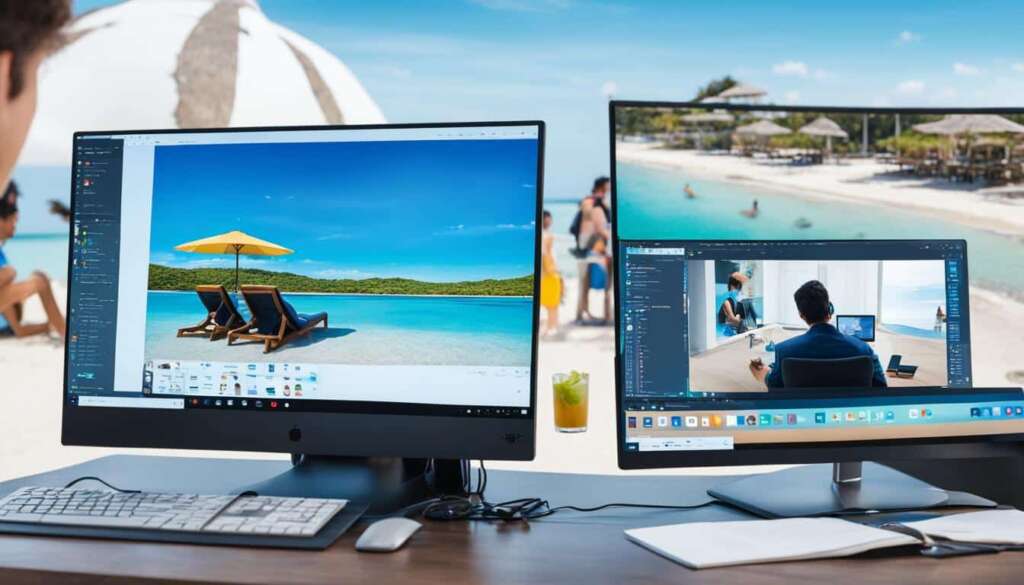Table of Contents
Remote desktop is a technology that allows users to connect to and control a computer or server remotely from another device. It is a form of virtual access that enables secure and agile connectivity from afar. Remote desktop is one of the most commonly used remote access protocols, which are widely used in technology today.
With remote desktop, individuals can access their files, applications, and data from anywhere in the world, as long as they have an internet connection. Whether you’re working from home, traveling, or providing technical support, remote desktop provides the flexibility to stay productive and connected.
Through remote desktop, users can see and control the desktop of the remote computer as if they were physically present. This technology has revolutionized the way businesses operate, allowing for seamless collaboration, increased efficiency, and improved accessibility.
By understanding the remote desktop protocol and how it works, you can harness the power of virtual access to enhance your productivity and connectivity. In the following sections, we will delve into the details of remote desktop, its security issues, the benefits of having an RDP server, and help you choose the right remote access solution for your needs.
What Is the Remote Desktop Protocol?
The Remote Desktop Protocol (RDP) is a network connection that enables remote access to another computer. When using RDP, the user runs the software on their device, establishes a connection, and can then see and interact with the desktop of the remote computer.
RDP is a Microsoft protocol and is included in Windows operating systems, making it widely used for server connections and accessing virtual computers. It provides a range of connection guides and technical information for users, ensuring a seamless remote desktop experience.
“RDP is the key to unlocking the full potential of remote access. It allows users to securely connect to their devices from anywhere, anytime, with ease.” – John Smith, IT Specialist
With RDP, users can remotely control a computer or server, accessing files, applications, and resources as if they were physically present. RDP facilitates efficient collaboration, supports remote troubleshooting, and enables remote support for technical issues. It is an invaluable tool for businesses with remote teams and individuals who frequently work away from their primary workstations.
Key Features of Remote Desktop Protocol
- Easy setup and configuration
- Secure encrypted connection
- Seamless integration with Windows operating systems
- Efficient resource utilization
- Multi-monitor support
https://www.youtube.com/watch?v=flPnBSz-lqw
By leveraging RDP, organizations can enhance productivity, streamline remote work processes, and ensure reliable access to critical resources. With its extensive connection guides and technical information, users can quickly set up and optimize their RDP connections, maximizing the benefits of remote desktop access.
How Does RDP Work?
RDP, or Remote Desktop Protocol, operates using two essential components: an RDP client and an RDP server. The RDP client is installed on the device from which access is requested, while the RDP server runs on the computer that is being accessed remotely. Once a connection is established, the client device mirrors the desktop of the remote computer, allowing the user to control it using a mouse and keyboard.
RDP relies on standard data transfer protocols, such as TCP/IP, to transfer screen information from the remote desktop to the client device. This ensures a seamless graphical interface, enabling the user to interact with the remote desktop just as if they were physically present. The data transfer protocols used by RDP facilitate the smooth transmission of images, graphical elements, and user input, ensuring a responsive and user-friendly experience.
“RDP enables users to access and control a remote computer with ease, offering a virtual workspace that can be accessed from anywhere.”
Secure Data Transfer Protocols
In order to provide secure remote access, RDP utilizes robust data transfer protocols. These protocols encrypt the data being transmitted between the client device and the remote desktop, ensuring confidentiality and protection against unauthorized access. By encrypting the data, RDP minimizes the risk of interception and tampering, safeguarding sensitive information during remote sessions.
Efficient Graphical Interface
RDP is known for its efficient graphical interface, which enables users to engage seamlessly with the remote desktop. The use of data transfer protocols specifically designed for graphical content ensures that images, animations, and other graphical elements are transmitted efficiently and displayed accurately on the client device. This ensures a visually appealing and responsive interface, enhancing the user experience during remote access sessions.
| Benefits of RDP | Features |
|---|---|
| Remote access convenience | Control a remote computer from anywhere |
| Flexible connectivity | Works over various networks and internet connections |
| Multimedia support | Efficient transmission of audio and video content |
| Secure data transfer | Encryption protocols protect sensitive information |
| Collaboration and teamwork | Facilitates remote collaboration and file sharing |
RDP Security Issues
RDP, or Remote Desktop Protocol, is an invaluable technology that allows for remote access to computers and servers. However, its widespread usage also brings about security risks and vulnerabilities. Cybercriminals have identified RDP as a prime target for their malicious activities, exploiting exposed RDP ports and weak passwords to gain unauthorized access to remote systems.
These security issues pose a significant threat to the confidentiality and integrity of sensitive information stored on remote computers. If cybercriminals successfully breach the security measures, they can potentially compromise data, install malware, or carry out other cyberattacks.
To mitigate these risks and strengthen RDP security, it is crucial to implement effective countermeasures. Some recommended practices include:
- Enable RDP Two-Factor Authentication (2FA): Implementing 2FA adds an extra layer of security by requiring users to provide an additional verification code or biometric authentication in addition to their passwords.
- Use an RDP Gateway: Deploying an RDP gateway acts as a secure intermediary between the remote user and the target computer or server, ensuring that all connections are monitored and controlled.
- Regularly Update and Patch RDP Software: Keeping RDP software up to date is crucial for staying protected against known vulnerabilities and exploits. Regularly applying patches and updates helps address security flaws and enhances system resilience.
- Implement Strong Password Policies: Encourage users to create complex, unique passwords for RDP access and enforce password policies that promote best practices, such as password length, complexity, and regular password changes.
It is essential to be proactive in addressing RDP security issues to safeguard remote access and protect valuable data from cyberattacks.

| Common RDP Security Issues | Recommended Countermeasures |
|---|---|
| Exposed RDP ports | Implement a firewall to restrict access to RDP ports and use port forwarding to limit exposure. |
| Weak passwords | Enforce strong password policies and educate users about the importance of using unique and robust passwords. |
| Outdated RDP software | Regularly update and patch RDP software to address known vulnerabilities and protect against exploits. |
| Misconfigured security settings | Ensure proper configuration of security settings, such as encryption and access controls, to enhance RDP security. |
| User account compromise | Implement 2FA for RDP access and regularly monitor user accounts for suspicious activity. |
Reasons Why You Need an RDP Server
An RDP server can be incredibly valuable in various situations, providing convenience, flexibility, and enhanced productivity. Let’s explore some of the key reasons why you should consider using an RDP server.
1. Remote Work and Travelling
If you frequently travel for work or find yourself working remotely, an RDP server is a game-changer. It allows you to access your workspace server from anywhere in the world, enabling seamless connectivity and uninterrupted workflow. Whether you’re in a hotel, airport, or co-working space, you can connect to your office computer and carry out your tasks efficiently.
2. Working from Home
With the rise of remote work, an RDP server becomes invaluable when you work from home. It offers you the flexibility to connect to your office computer, access files, applications, and resources remotely. You can collaborate with colleagues, attend meetings, and complete your work tasks as if you were physically present in the office. Thanks to RDP, your home can truly be your productive workspace.
3. Technical Support
Using an RDP server is an effective way to provide technical support to remote users. Instead of struggling with phone instructions or incomplete descriptions, support teams can connect directly to the user’s computer and troubleshoot issues in real-time. This enables faster problem resolution, saves time and resources, and enhances customer satisfaction.
4. Overcoming Hardware Limitations
If you’re working with hardware-intensive applications or resource-demanding software, an RDP server can help overcome hardware limitations. Even if your local device doesn’t meet the necessary requirements, you can leverage the power of a remote server to run applications smoothly. This eliminates the need for expensive hardware upgrades and allows you to access advanced tools without relying on your local machine.
5. Crypto Trading and Restricted Access
In countries with restricted access to crypto trading platforms, an RDP server can be a valuable tool. It allows you to connect to a server located in a different region, bypassing any geographical limitations. This enables you to engage in crypto trading seamlessly, access market data, and execute trades, regardless of your physical location.
6. Testing Bot Software
If you’re into botting RDP, an RDP server is an essential tool for testing your software before release. It provides a controlled environment to evaluate the performance, efficiency, and effectiveness of your bot applications. By simulating various scenarios and monitoring the outcomes, you can refine and optimize your bot software for optimal results.
Overall, an RDP server opens up a world of possibilities, from enabling remote work and seamless connectivity to overcoming hardware limitations and engaging in specialized activities like crypto trading and botting RDP. Incorporating an RDP server into your workflow can enhance productivity, streamline operations, and empower you to work efficiently from anywhere.
| RDP Server Benefits | Examples |
|---|---|
| Remote Work | Accessing office computer from home |
| Traveling | Connecting to workspace server while on the go |
| Technical Support | Assisting users remotely |
| Hardware Limitations | Running resource-intensive applications |
| Crypto Trading | Bypassing geographical restrictions |
| Bot Software Testing | Evaluating bot performance |
Remote Desktop Protocol (RDP) offers two distinct options for users: shared RDP and admin RDP. Understanding the differences between these two choices is crucial to achieving optimal website performance and maintaining control over your remote desktop environment.
Shared RDP, as the name suggests, involves multiple users sharing the same resources on a server. While this may seem like a cost-effective solution, it can lead to several challenges. One of the main drawbacks is the potential for unstable website performance. When multiple users are concurrently accessing the server, it can strain the available resources, resulting in slower response times and diminished user experience.
Additionally, shared RDP often comes with limited control over the server. As a user, you may not have the ability to install certain software or customize the server environment to suit your specific needs. This lack of control can hinder productivity and restrict the full potential of your remote desktop experience.
Shared RDP can provide a budget-friendly option for remote access, but it may come with compromised website performance and a lack of control over the server environment.
Admin RDP
On the other hand, admin RDP offers dedicated resources for individual users, ensuring better website performance and greater control. With admin RDP, you can enjoy faster response times and smoother operations, as the resources are exclusively allocated to your needs.
Admin RDP also provides enhanced control over the server environment. You have the flexibility to install custom software, make configuration changes, and tailor the server settings according to your preferences. This level of control empowers you to optimize your remote desktop experience and maximize efficiency.
The Importance of IP Address
Another significant difference between shared RDP and admin RDP lies in the IP address assigned to your remote desktop. Shared RDP often utilizes a shared IP address, meaning multiple users are associated with the same IP. This can raise concerns about security and reputation, as the actions of one user can potentially impact the entire IP address. On the other hand, admin RDP typically provides a dedicated IP address, ensuring your activities remain separate and safeguarded.
The Benefits of Admin RDP
- Improved website performance and faster response times
- Full control over the server environment
- Customizability to meet specific needs
- A dedicated IP address for enhanced security and reputation
By choosing admin RDP, you can experience the advantages of better website performance, increased control, and a dedicated IP address. These benefits contribute to a seamless remote desktop experience, allowing you to work efficiently and securely.
VNC or RDP? Choosing the Right Remote Access Solution
When businesses consider remote access options, they often find themselves deliberating between two popular choices: VNC and RDP. VNC, which stands for Virtual Network Computing, is a versatile graphical desktop sharing system that enables remote control of computers across a range of operating systems. Conversely, RDP (Remote Desktop Protocol) is a proprietary protocol developed by Microsoft, primarily offering virtual session-based remote desktop capabilities for Windows systems.
One key factor to consider when making a decision between VNC and RDP is cross-platform compatibility. VNC’s platform independence allows for seamless remote control of computers irrespective of the operating system being used. This level of flexibility empowers businesses with diverse IT environments to maintain remote access capabilities across a wide range of devices. On the other hand, RDP is more suitable for strictly Windows-centric environments, where virtual desktop access and management within the Windows ecosystem is of paramount importance.
Another critical aspect to consider is security. Both VNC and RDP offer secure remote access options, but the level of security may differ. Businesses with stringent security requirements may lean towards RDP due to its integration with native Windows security features. Conversely, VNC’s open-source nature and community-driven development can provide additional flexibility for organizations with specific security protocols in place. It’s important to assess the security needs of your business and choose the solution that best aligns with those requirements.
Ultimately, when choosing between VNC and RDP for remote access, businesses should evaluate their specific needs and consider factors such as cross-platform compatibility, security, and the specific IT environment. By carefully assessing these factors, organizations can make an informed decision and select the remote access solution that best facilitates their operations and enhances productivity while maintaining the necessary levels of security.
FAQ
What is Remote Desktop?
Remote Desktop is a technology that allows users to connect to and control a computer or server remotely from another device. It provides virtual access for secure and agile connectivity from afar.
What is the Remote Desktop Protocol (RDP)?
The Remote Desktop Protocol (RDP) is a network connection that enables remote access to another computer. It allows users to see and interact with the desktop of the remote computer by running the RDP software on their device.
How does RDP work?
RDP requires two pieces of software: an RDP client on the device requesting access and an RDP server on the computer being accessed. The client device displays the remote computer’s desktop, allowing the user to control it using their mouse and keyboard.
What are the security issues with RDP?
RDP, being widely used, poses security risks. Weak passwords and exposed RDP ports can make it easier for hackers to gain unauthorized access to remote computers. Implementing measures like RDP Two-Factor Authentication (2FA) and using an RDP gateway can enhance security.
Why do I need an RDP server?
Having an RDP server is beneficial for various situations. It allows users to access their workspace server while traveling for work or connect to their office computer while working from home. RDP servers are also useful for providing technical support, overcoming hardware limitations, engaging in crypto trading, and testing bot software.
Shared RDP involves multiple users utilizing the same resources on a server, which can result in unstable website performance and lack of control. Admin RDP, on the other hand, provides dedicated resources for individual users, offering better performance and control.
Should I choose VNC or RDP for remote access?
The choice between VNC and RDP depends on factors such as cross-platform compatibility, security requirements, and specific business needs. VNC is platform-independent, allowing remote control of computers across different operating systems, while RDP is primarily designed for Windows systems.












